Euphorbia milii
Euphorbia milii, the crown of thorns, Christ plant, or Christ thorn, called Corona de Cristo in Latin America (coroa-de-cristo in Brazil), is a species of flowering plant in the spurge family Euphorbiaciae, native to Madagascar. The species name commemorates Baron Milius, once Governor of Réunion, who introduced the species to France in 1821.[2] It is imagined that the species was introduced to the Middle East in ancient times, and legend associates it with the crown of thorns worn by Christ.[2]
| Euphorbia milii | |
|---|---|
 | |
 | |
| Christ thorn (large) | |
| Scientific classification | |
| Kingdom: | Plantae |
| Clade: | Tracheophytes |
| Clade: | Angiosperms |
| Clade: | Eudicots |
| Clade: | Rosids |
| Order: | Malpighiales |
| Family: | Euphorbiaceae |
| Genus: | Euphorbia |
| Species: | E. milii |
| Binomial name | |
| Euphorbia milii | |
Description
It is a succulent subshrub or shrub growing to 1.8 m (5 ft 11 in) tall, with densely spiny stems. The straight, slender spines, up to 3 cm (1.2 in) long, help it scramble over other plants. The leaves are found mainly on new growth,[2] and are up to 3.5 cm (1.4 in) long and 1.5 cm (0.59 in) broad. The flowers are small, subtended by a pair of conspicuous petal-like bracts, variably red, pink or white, up to 12 mm (0.47 in) broad.[3] The sap is moderately poisonous, and causes irritation on contact with skin or eyes. If ingested, it causes severe stomach pain, irritation of the throat and mouth, and vomiting. The poisonous ingredients have been identified as phorbol esters.[4] Wat Phrik in Thailand claims to be the home of the world's tallest Christ thorn plant.[5]
Euphorbia milii can be propagated from cuttings.[6]
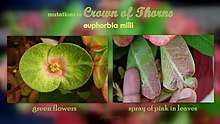
Varieties
E. milii is a variable species, and several varieties have been described; some of these are treated as distinct species by some authors.[3] E. milii var. splendens (syn. E. splendens) is considered to be the living embodiment of the supreme deity in Bathouism, a minority religion practiced by the Bodo people of Eastern India and Nepal.
- Euphorbia milii var. bevilaniensis (Croizat) Ursch & Leandri 1955
- Euphorbia milii var. hislopii (N.E.Br.) Ursch & Leandri 1955 (syn. E. hislopii)
- Euphorbia milii var. imperatae (Leandri) Ursch & Leandri 1955
- Euphorbia milii var. longifolia Rauh 1967
- Euphorbia milii var. milii
- Euphorbia milii var. roseana Marn.-Lap. 1962
- Euphorbia milii var. splendens (Bojer ex Hook.) Ursch & Leandri 1955
- Euphorbia milii var. tananarivae (Leandri) Ursch & Leandri 1955
- Euphorbia milii var. tenuispina Rauh & Razaf. 1991
- Euphorbia milii var. tulearensis Ursch & Leandri 1955
- Euphorbia milii var. vulcanii (Leandri) Ursch & Leandri 1955
Cultivation
E. milii is not hardy, and does not tolerate temperatures below 10 °C (50 °F). In temperate areas it needs to be grown under glass in full sun. During the summer it may be placed outside in a sheltered spot, when all risk of frost is absent. The species[7]and the variety E. milii var. splendens[8] have both gained the Royal Horticultural Society’s Award of Garden Merit.[9]
Gallery
 Euphorbia Milii Crown of Thorns
Euphorbia Milii Crown of Thorns Christ thorn inflorescences (cyathia) opening
Christ thorn inflorescences (cyathia) opening Emerging stem
Emerging stem Christ thorn inflorescence (cyathium) close up view
Christ thorn inflorescence (cyathium) close up view Euphorbia milii var splendens
Euphorbia milii var splendens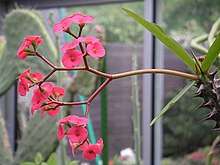 Euphorbia milii
Euphorbia milii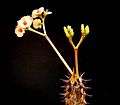 Euphorbia milii var. vulcanii
Euphorbia milii var. vulcanii- Euphorbia milii var. milii
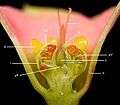 Longitudinal-section of the cyathium
Longitudinal-section of the cyathium Grown in Malaysia
Grown in Malaysia Infected euphorbia inflorescences (cyathia)
Infected euphorbia inflorescences (cyathia) Close-up view of Euphorbia milii
Close-up view of Euphorbia milii In Prague botanic garden
In Prague botanic garden Euphorbia milii from Kerala, India
Euphorbia milii from Kerala, India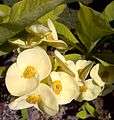 Euphorbia milii in Pakistan
Euphorbia milii in Pakistan
References
| Wikimedia Commons has media related to Euphorbia milii. |
- Razanajatovo, H. (2020). "Euphorbia milii". IUCN Red List of Threatened Species. 2020. Retrieved 28 June 2020.
- Ombrello, Dr T., Crown of Thorns, Plant of the Week, UCC Biology Department, archived from the original on 17 September 2009, retrieved 1 October 2009
- Huxley, A., ed. (1992). New RHS Dictionary of Gardening. ISBN 978-0-333-47494-5.
- "Crown-of-Thorns (Euphorbia milii)". Veterinary Medicine Library. University Library, University of Illinois at Urbana-Champaign. Archived from the original on 2017-03-23. Retrieved 2017-04-08.
- ThaiTambon.com
- Complete Guide to Houseplants. Meredith Publishing Group.
- "RHS Plantfinder - Euphorbia milii". Retrieved 23 February 2018.
- "RHS Plantfinder - Euphorbia milii var. splendens". Retrieved 14 February 2018.
- "AGM Plants - Ornamental" (PDF). Royal Horticultural Society. July 2017. p. 35. Retrieved 16 February 2018.
